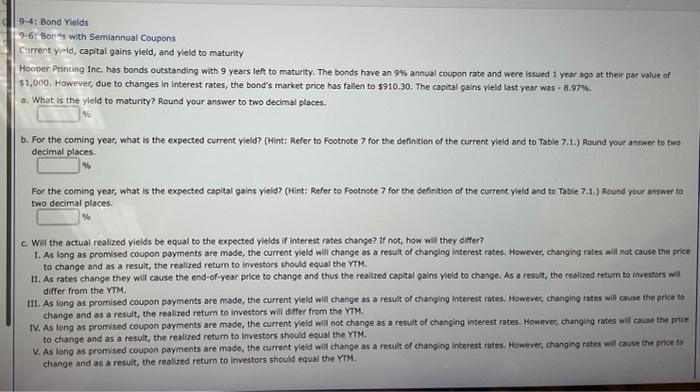9-6: 8on-15 with Semiannual Coupons Current yield, capital gains yield, and yield to maturity Hooper Printing Inc. has bonds outstanding with 9 years left to maturity. The bonds have an 9% annual coupon rate and were issued 1 year ago at their par value of 51,000. However, due to changes in interest rates, the bond's market price has fallen to 5910.30. The capital gains yield last year was - 8.975. a. What is the yleld to maturity? Round your answer to two decimal places. b. For the coming year, what is the expected current yield? (Hint: Refer to Footnote 7 for the definitlon of the current yield and to Table 7.1.) Round your anwwer to two decimal places. For the coming year, what is the expected capital gains yield? (Hint: Refer to Footnote 7 for the definition of the current yield and to table 7.1.) Round your answer to two decimal places. % c. Win the actual realized yieids be equal to the expected yitids if interest rates change? If not, how will they differ? 1. As long as promised coupon payments are made, the current yield will change as a result of changing iaterest rates. However, changing rates aill not cause the price to change and as a result, the realized return to investors should equal the Yth. If. As rates change they will cause the end-of-year price to change and thus the reailzed capital gains yield to change. As a result, the realited return to investors will differ from the YTM. III. As long as promised coupon payments are msde, the current yield will change as a resuit of changing interest rates. However, changing rates will cause the price to change and as a result, the realized return to investors will differ from the YTM. IV. As long as promised coupon payments are made, the current yield will not change as a result of changing interest rates. Howevec, changing rates all cause the price to change and as a result, the realized return to investors should equal the YTM. V. As long as promised coupon payments are made, the current yield will change as a result of changing interest rates. However, changing rates nill cause the arice to change and as a result, the realized return to investors should equal the YTM







